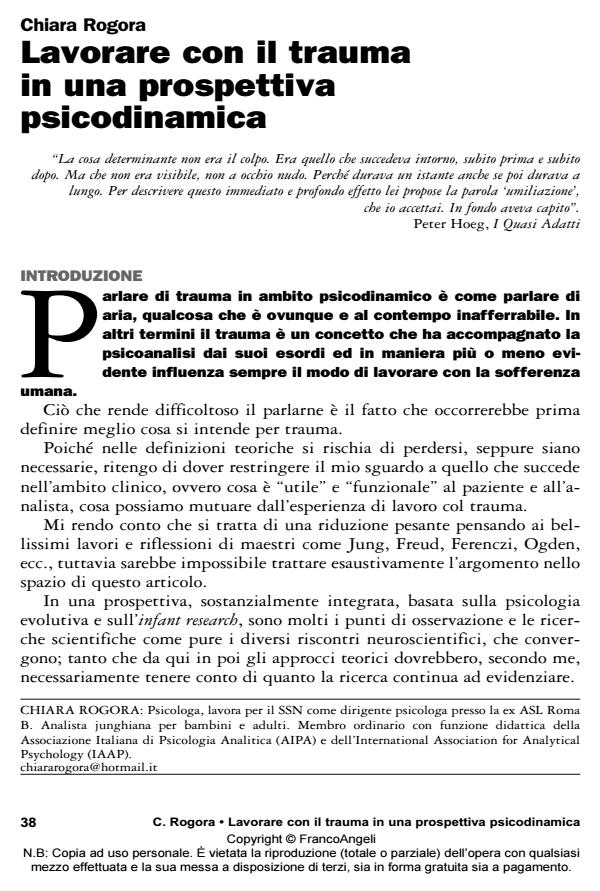Lavorare con il trauma in una prospettiva psicodinamica
Titolo Rivista PSICOBIETTIVO
Autori/Curatori Chiara Rogora
Anno di pubblicazione 2016 Fascicolo 2016/1
Lingua Italiano Numero pagine 19 P. 38-56 Dimensione file 120 KB
DOI 10.3280/PSOB2016-001003
Il DOI è il codice a barre della proprietà intellettuale: per saperne di più
clicca qui
Qui sotto puoi vedere in anteprima la prima pagina di questo articolo.
Se questo articolo ti interessa, lo puoi acquistare (e scaricare in formato pdf) seguendo le facili indicazioni per acquistare il download credit. Acquista Download Credits per scaricare questo Articolo in formato PDF

FrancoAngeli è membro della Publishers International Linking Association, Inc (PILA)associazione indipendente e non profit per facilitare (attraverso i servizi tecnologici implementati da CrossRef.org) l’accesso degli studiosi ai contenuti digitali nelle pubblicazioni professionali e scientifiche
In questo articolo l’autrice parla di trauma in una prospettiva psicodinamica, ripercorrendo le ricerche in età evolutiva e le scoperte delle neuroscienze, affronta un cambiamento di paradigma che vede il trauma al centro della psicopatologia moderna e necessariamente della terapia. In particolare parla del trauma relazionale precoce e di quei traumi silenziosi e cumulativi che comportano veri e propri danni nell’apparato relazionale del bambino. Il trauma, l’attaccamento, le neuroscienze ridefiniscono il modo di lavorare in senso psicodinamico non tanto per quanto riguarda la cornice teorica ma soprattutto per l’assetto analitico, poiché la relazione diviene il fattore terapeutico e ad essa va dedicata la massima attenzione. Le componenti implicite della relazione e la compartecipazione inconscia dell’analista vengono rimodulati sui bisogni del paziente vittima di traumi. Attraverso la presentazione di un caso clinico mostrerà il proprio modo di intendere l’approccio psicodinamico.
Parole chiave:Trauma; attaccamento; neuroscienze; trauma relazionale; dissociazione
- Terr L. (2009) “I traumi infantili”, in Williams R. (a cura di), Trauma e relazioni Le prospettive scientifiche e cliniche contemporanee, Raffaello Cortina, Milano
- Tronick E. (2008) Regolazione emotiva, Raffaello Cortina, Milano
- Van der Kolk B. (2014) The Body Keeps the Score (trad. it. Il corpo accusa il colpo, Raffaello Cortina, Milano, 2015)
- Wilkinson M. (2010) Changing Minds in Therapy. Emotion Attachment Trauma & Neurobiology, Norton & Company, NY
- Williams R. (a cura di) (2009) Trauma e relazioni. Le prospettive scientifiche e cliniche contemporanee, Raffaello Cortina, Milano
- Winnicott D. (1965) The maturational processes and the facilitating environment. Study in the theory of emotional development (trad. it. Sviluppo affettivo e ambiente, Armando, Roma, 1970)
- Woodhead J. (2010) “Trauma in the crucible of the parent-infant relationship: The baby’s experience”, in Baradon T. (ed.), Relational Trauma in Infancy, Routledge, East Sussex
- Bion W. (1962) Learning from experience, Karnac Book, London, trad it. Apprendere dall’Esperienza, Armando, Roma, 1988
- Blundo C. (2011) Neuroscienze Cliniche del Comportamento, III ed., Elsevier, Milano
- Boston Change Process Study Group (2007) “The foundational level of psychodynamic meaning: Implicit process in relation to conflict, defense and the dynamic unconscius”, International Journal of Psychoanalysis, 88, 4: 843-860 (trad. it. in Lyons-Ruth K., Il trauma latente nel dialogo relazionale dell’infanzia, a cura di R. Tambelli e C. Zaccagnini, Borla, Roma, 2012)
- Bromberg P. (2001) Standing in the Space. Essays on Clinical Process, Trauma, and Dissociation, The Analytic Press, Inc. (trad it. Clinica del trauma e della dissociazione, Raffaello Cortina, Milano, 2007)
- Bromberg P. (2009) “È stato il gorilla. Alcune considerazioni sullo stato dissociativo, il reale e il realmente reale”, in Williams R. (a cura di), Trauma e relazioni. Le prospettive scientifiche e cliniche contemporanee, Raffaello Cortina, Milano
- Bromberg P. (2011) L’Ombra dello Tsunami. La crescita della Mente relazionale, Raffaello Cortina, Milano, 2012
- Fonagy P., Target M. (2001) Attaccamento e funzione riflessiva, Raffaello Cortina, Milano
- Kalsched D. (1996) The Inner World of Trauma, Routledge, East Sussex (trad. it. Il mondo interiore del trauma, Moretti & Vitali, Bergamo, 2001)
- Lingiardi V., Gazzillo F. (2014) La personalità e i suoi disturbi, Raffaello Cortina, Milano
- Liotti G. (1992) “La disorganizzazione dell’attaccamento come modello per comprendere la patologia dissociativa”, in Solomon J., George C. (a cura di), L’attaccamento disorganizzato, Il Mulino, Bologna, 2007
- Lyons-Ruth K., Dutra L., Schuder M., Bianche I. (2009) “Il legame tra disorganizzazione dell’attaccamento in età infantile e dissociazione in età adulta. Adattamenti relazionali o esperienze traumatiche?”, in Williams R. (a cura di), Trauma e relazioni Le prospettive scientifiche e cliniche contemporanee, Raffaello Cortina, Milano
- Meares R. (2009) “La memoria episodica, il trauma e la narrazione del Sé”, in Williams R. (a cura di), Trauma e relazioni. Le prospettive scientifiche e cliniche contemporanee, Raffaello Cortina, Milano
- Meares R. (2012) A Dissociation Model of Borderline Personality (trad. it. Un modello dissociativo del disturbo borderline di personalità, Raffaello Cortina, Milano, 2014)
- Perry B.D. (2009) “Esperienza infantile ed espressione del potenziale genetico”, in Williams R. (a cura di), Trauma e relazioni Le prospettive scientifiche e cliniche contemporanee, Raffaello Cortina, Milano
- Schore A. (2003) Affect regulation and the repair of the self, Norton & Company, NY (trad. it. La regolazione degli affetti e la riparazione del Sé, Astrolabio, Roma, 2008)
- Schore A. (2009) “La disregolazione dell’emisfero destro. Attaccamento traumatico e psicopatogenesi del disturbo post traumatico da stress”, in Williams R. (a cura di), Trauma e relazioni Le prospettive scientifiche e cliniche contemporanee, Raffaello Cortina, Milano
- Schore A. (2010) “Relational trauma and the developing right brain: The neurobiology of broken attachment bonds”, in Baradon T. (ed.), Relational Trauma in Infancy, Routledge, East Sussex
- Stern D. (1985) The interpersonal World of the Infant (trad. it. Il Mondo interpersonale del bambino, Boringhieri, Torino, 1987)
Chiara Rogora, Lavorare con il trauma in una prospettiva psicodinamica in "PSICOBIETTIVO" 1/2016, pp 38-56, DOI: 10.3280/PSOB2016-001003